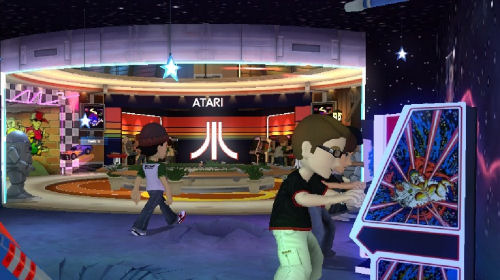It has been over two months since Game Room, Microsoft's highly hyped classic game platform, was released on Xbox Live. As a fan of vintage video games, both in arcades and on old school consoles like the Atari 2600, I was very excited on release day. Game Room looked to be a perfect fusion of retro charm, high def visuals, and the social element that is so important to modern gaming. But as with many such overhyped products, Game Room has turned out to be a disappointment. While not a total failure, by any means, Game Room's focus on single player games and inadequate multiplayer options, particularly co-op, is disheartening for even the staunchest classic gaming fan.
Let's begin by discussing what Game Room does right. First and foremost is the virtual arcade environment itself. With a variety of props and themes, each room in the spacious arcade space can be customized and tweaked to your liking. It's quite enjoyable to get your cabinets and consoles placed just right and search for the perfect accessories to go with them. On launch day, I eagerly plopped down my Centipede and Tempest cabinets, found a nice change machine and a stool or two, and in a flash, I had a reasonable facsimile of a small arcade you might have found at a mall or grocery store in 1984. Moving around my new arcade was very immersive, especially with the ambient arcade blips, bleeps, and music tickling my ears in the background. Friends pop in from time to time, adding to the authentic feel. Simply put, the environment of your own Game Room arcade adds to the enjoyment of playing the games themselves.

Another virtue of the Game Room service is easy access to classic games of the past. Certainly, there are several all-stars of the Golden Age of the Arcade that have been rereleased repeatedly through the years; in fact, Xbox Live Arcade has already been home to quite a few, including Pac-Man, Frogger, and Joust. But for more obscure titles, especially those on the vintage home consoles, options have historically been quite limited. Either you use an emulator of questionable legality, or you hunt down an old copy of the game and a console to play it on. Both of these options are more trouble than the average fan is going to bother with. Game Room brings these hard to find, old-school experiences right into your living room, and you can even try them out before you buy. As time goes on, and the Game Room library increases in size, this access will become even more significant.
But a fancy environment and easy content delivery are not enough for modern gamers. Social networking is the order of the day, and nowhere is this more obvious than in video gaming. Friends lists, multiplayer modes, leaderboards, and achievements are expected to be a big part of any game, even more so for a downloadable game on Xbox Live. While Game Room does address these expectations, it does so only halfheartedly. Progression in Game Room is extremely simple; players "level up" by earning medals, yet they earn medals in only a few ways, like surviving a set period of time, or reaching a high score point threshold. This scheme is too straightforward and simplistic. Why not change up the formula a bit, as the best achivements for other games do? Include game altering medals that add to the replay value of the games. An example might be surviving a certain number of waves without using the superzapper in Tempest, or shooting the spider within a brief time limit each time it pops up in Centipede. This type of "game within a game" medal system would go a long way to increasing the perceived value of the games themselves, which is sorely needed at $3 a pop. As it stands, the best way to earn medals and unlock cool stuff is to buy more games for your collection, trading money for advancement, and this can leave a bad taste in players' mouths.
.jpg)